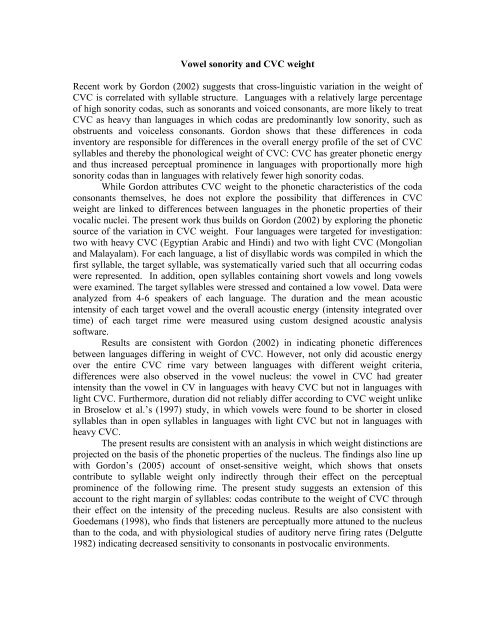Vowel sonority and coda weight - Linguistics
Vowel sonority and coda weight - Linguistics
Vowel sonority and coda weight - Linguistics
You also want an ePaper? Increase the reach of your titles
YUMPU automatically turns print PDFs into web optimized ePapers that Google loves.
<strong>Vowel</strong> <strong>sonority</strong> <strong>and</strong> CVC <strong>weight</strong><br />
Recent work by Gordon (2002) suggests that cross-linguistic variation in the <strong>weight</strong> of<br />
CVC is correlated with syllable structure. Languages with a relatively large percentage<br />
of high <strong>sonority</strong> <strong>coda</strong>s, such as sonorants <strong>and</strong> voiced consonants, are more likely to treat<br />
CVC as heavy than languages in which <strong>coda</strong>s are predominantly low <strong>sonority</strong>, such as<br />
obstruents <strong>and</strong> voiceless consonants. Gordon shows that these differences in <strong>coda</strong><br />
inventory are responsible for differences in the overall energy profile of the set of CVC<br />
syllables <strong>and</strong> thereby the phonological <strong>weight</strong> of CVC: CVC has greater phonetic energy<br />
<strong>and</strong> thus increased perceptual prominence in languages with proportionally more high<br />
<strong>sonority</strong> <strong>coda</strong>s than in languages with relatively fewer high <strong>sonority</strong> <strong>coda</strong>s.<br />
While Gordon attributes CVC <strong>weight</strong> to the phonetic characteristics of the <strong>coda</strong><br />
consonants themselves, he does not explore the possibility that differences in CVC<br />
<strong>weight</strong> are linked to differences between languages in the phonetic properties of their<br />
vocalic nuclei. The present work thus builds on Gordon (2002) by exploring the phonetic<br />
source of the variation in CVC <strong>weight</strong>. Four languages were targeted for investigation:<br />
two with heavy CVC (Egyptian Arabic <strong>and</strong> Hindi) <strong>and</strong> two with light CVC (Mongolian<br />
<strong>and</strong> Malayalam). For each language, a list of disyllabic words was compiled in which the<br />
first syllable, the target syllable, was systematically varied such that all occurring <strong>coda</strong>s<br />
were represented. In addition, open syllables containing short vowels <strong>and</strong> long vowels<br />
were examined. The target syllables were stressed <strong>and</strong> contained a low vowel. Data were<br />
analyzed from 4-6 speakers of each language. The duration <strong>and</strong> the mean acoustic<br />
intensity of each target vowel <strong>and</strong> the overall acoustic energy (intensity integrated over<br />
time) of each target rime were measured using custom designed acoustic analysis<br />
software.<br />
Results are consistent with Gordon (2002) in indicating phonetic differences<br />
between languages differing in <strong>weight</strong> of CVC. However, not only did acoustic energy<br />
over the entire CVC rime vary between languages with different <strong>weight</strong> criteria,<br />
differences were also observed in the vowel nucleus: the vowel in CVC had greater<br />
intensity than the vowel in CV in languages with heavy CVC but not in languages with<br />
light CVC. Furthermore, duration did not reliably differ according to CVC <strong>weight</strong> unlike<br />
in Broselow et al.’s (1997) study, in which vowels were found to be shorter in closed<br />
syllables than in open syllables in languages with light CVC but not in languages with<br />
heavy CVC.<br />
The present results are consistent with an analysis in which <strong>weight</strong> distinctions are<br />
projected on the basis of the phonetic properties of the nucleus. The findings also line up<br />
with Gordon’s (2005) account of onset-sensitive <strong>weight</strong>, which shows that onsets<br />
contribute to syllable <strong>weight</strong> only indirectly through their effect on the perceptual<br />
prominence of the following rime. The present study suggests an extension of this<br />
account to the right margin of syllables: <strong>coda</strong>s contribute to the <strong>weight</strong> of CVC through<br />
their effect on the intensity of the preceding nucleus. Results are also consistent with<br />
Goedemans (1998), who finds that listeners are perceptually more attuned to the nucleus<br />
than to the <strong>coda</strong>, <strong>and</strong> with physiological studies of auditory nerve firing rates (Delgutte<br />
1982) indicating decreased sensitivity to consonants in postvocalic environments.
References<br />
Broselow, Ellen, Chen, Susan, <strong>and</strong> Marie Huffman. 1997. Syllable <strong>weight</strong>: convergence<br />
of phonology <strong>and</strong> phonetics. Phonology 14, 47-82.<br />
Delgutte, Bertr<strong>and</strong>. 1982. Some correlates of phonetic distinctions at the level of the<br />
auditory nerve. In Carlson, Rolf <strong>and</strong> Björn Granström (eds.), The representation of<br />
speech in the peripheral auditory system, pp. 131-50. Amsterdam: Elsevier.<br />
Goedemans, Rob. 1998. Weightless segments. The Hague: Holl<strong>and</strong> Academic Graphics.<br />
Gordon, Matthew. 2002. Weight-by-positon adjunction <strong>and</strong> syllable structure. Lingua<br />
112, 901-931.<br />
Gordon, Matthew. 2005. A perceptually-driven account of onset-sensitive stress. Natural<br />
Language <strong>and</strong> Linguistic Theory 23, 595-653.

















